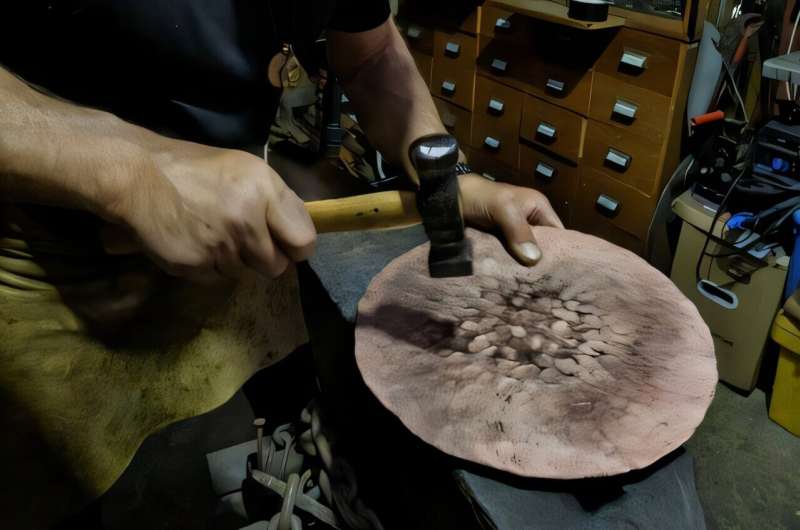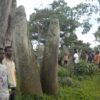by Oliver Dietrich, Landesamt für Denkmalpflege und Archäologie Sachsen-Anhalt – Landesmuseum für Vorgeschichte
The Nebra Sky Disc, which is more than 3,600 years old, is a unique find of international standing and has been part of the UNESCO “Memory of the World” register since 2013. It can be considered one of the best-researched archaeological objects, but the question of the manufacturing process of the object has not yet been completely clarified.
Based on its material composition and previous research, it was known that the disk could not have been simply cast in its final size. New metallographic analyses show that the Sky Disc was manufactured using a complex hot forging process. Until it reached its final dimensions, around ten cycles were necessary, each of which included heating to around 700°C, forging and then annealing to relax the metal structure again.
Since it was seized by the police and returned to Saxony-Anhalt in 2002, it has been the subject of extensive scientific investigations, which in recent years have yielded important insights into, for example, the raw materials or the original color of the Sky Disc.
Based on its material composition and previous research, it was known that the disk could not have been simply cast in its final size.
Despite its simple appearance, forging a bronze disk with a diameter of around 31 centimeters and a thickness of a few millimeters is by no means a trivial task. The latest metallographic studies, now published in Scientific Reports, were therefore devoted to the question of how the bronze disk was made from a casting.
The research was conducted by the State Office for Heritage Management and Archaeology Saxony-Anhalt in cooperation with the Otto von Guericke University Magdeburg, Chair of Metallic Materials (Prof. Dr. Thorsten Halle), and the company DeltaSigma Analytics GmbH, Magdeburg. The latest metallographic techniques were used.

The copper smith (Herbert R. Bauer) producing a replica of the Nebra Sky Disc by helical hammer forging. © Juraj Lipták
A small sample from the outer area of the Sky Disc, which was first taken in 2002 for various archaeometallurgical research and has since been re-inserted, was again temporarily removed and re-examined. In addition to microstructural analyses on color-etched surfaces with a light microscope, the most modern imaging methods were used: energy dispersive X-ray spectroscopy and electron backscatter diffraction.
Hardness measurements were also carried out. These were accompanied by parallel experimental tests, in which the experienced coppersmith Herbert Bauer, Halle (Saale), made a replica from a cast blank.
The results of the metallographic analyses show that the Sky Disc was manufactured in a complex hot forging process. Until it reached its final dimensions, around ten cycles were necessary, each of which included heating to around 700 °C, forging and then annealing to relax the metal structure again.
In his experiments, H. Bauer had to carry out significantly more forging cycles to produce the copy than could be proven for the original Sky Disc. The cast blank of the original must have been slightly larger and thinner than the one used for the replica.
“That the investigations continue to produce such fundamental new findings more than 20 years after the Sky Disc was secured not only once again demonstrates the extraordinary character of this find of the century, but also how highly developed the art of metal processing was already in the Early Bronze Age,” says State archaeologist Prof. Dr. Harald Meller.
The latest research results make it clear that the early Bronze Age craftsmen were not only outstanding casters, but also mastered complex bronze processing techniques, for example hot forging, at the highest level. With their extensive experience and knowledge, they were not only able to produce numerous axes in series production, but also to forge a workpiece that is unique from today’s perspective, such as the Nebra Sky Disc.
“In addition, the Sky Disc shows how important it is to re-examine seemingly well-known finds when new methods become available,” says Meller.
More information:
Sebastian Dieck et al, Archaeometallurgical investigation of the Nebra Sky Disc, Scientific Reports (2024). DOI: 10.1038/s41598-024-80545-5
Provided by
Landesamt für Denkmalpflege und Archäologie Sachsen-Anhalt – Landesmuseum für Vorgeschichte
Citation:
How did they make it? New insights into the production of the Nebra Sky Disc (2024, November 29)



